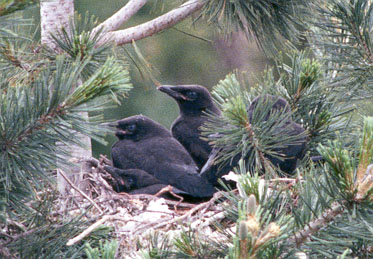 TABLE
OF CONTENTS
TABLE
OF CONTENTSConservation
of Forest Songbirds
in the Puget Sound Area
Research conducted through the
College of Forest Resources
University of Washington
 TABLE
OF CONTENTS
TABLE
OF CONTENTS
West
Nile Virus Alert
Songbird identification guide NEW!!!
Report colorbanded songbirds NEW!!!
Urban birds of Puget Sound NEW - FOR STUDENTS!!!
Research overview
Research sites
Ubiquitous American Crow
Research methods
Opportunities for assistance
Independent studies by UW students
Landscaping for native songbirds
Report banded American Crows
Presentations and publications
Acknowledgments
Related links
Contact information
RESEARCH OVERVIEW
The Puget Sound Area has seen a dramatic increase in the number of human residents and accompanying over the last 20 years. Development will continue as the region adds another million people between now and 2020 (Puget Sound Regional Council). Development negatively impacts native wildlife by reducing the amount of suitable habitat and fragmenting that which remains. To date, wildlife conservation strategies have focused almost completely on creating networks of habitat reserves. Unfortunately, the establishment of these a reserve network that provides for viable populations of many wildlife species is a difficult or impossible task in urbanizing areas; Development pressure and property values are simply too great. Therefore, it is imperative that we begin to manage native wildlife using both reserves and the Matrix, or development between habitat reserves.
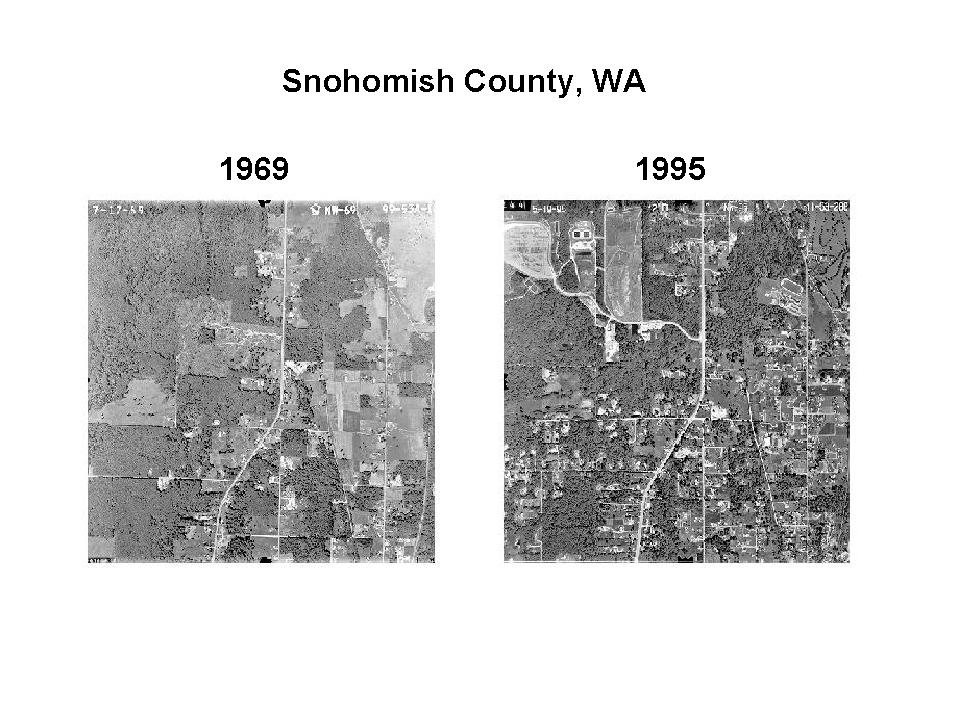
Our research investigates how to use habitat reserves and matrix pattern to conserve native forest songbirds in the urbanizing Puget Sound lowlands. We have two main objectives: (1) to determine how urban pattern surrounding reserve and matrix sites correlates with avian productivity and (2) to determine the mechanism creating this correlation. Our working hypothesis is that is that development leads to changes in the nest predator community, increased nest predation rates, and a reduction in productivity for many native bird species.
To accomplish the first objective, we select study sites across the metropolitan area using three newly developed urban spatial pattern metrics that are believed to be ecologically meaningful and sensitive to extant regulatory mechanisms (state/county). We select reserves and single-family housing developments spanning the available range of these metrics and the combinations thereof. At each of these sites we survey breeding birds, estimate the productivity of avian nesting guilds, and survey potential nest predators.
We will accomplish the second objective using many of the same procedures. However, for this portion of the study we select forested sites that are slated for near-term development so that we can experimentally test the hypotheses derived from the sites that have already been developed. Experimental sites that are not developed during the course of the study will be used as experimental controls. Our approach to urban bird ecology improves on that of similar studies by employing (1) detailed metrics of urban pattern, (2) direct measures avian productivity, and (3) experimentation.
RESEARCH SITES
To cover the ranges of the urban spatial pattern metrics that exist in the Puget Sound area, we select many sites across a broad geographic area. Metric values for individual sites are calculated by interpreting the light reflected by the land cover. In this particular satellite image, red=impervious surface, green=vegetation, and blue=rock/soil.
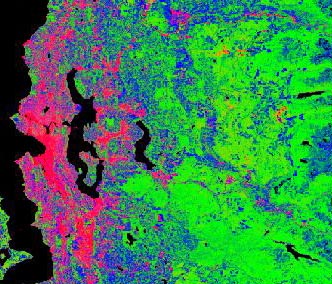
UBIQUITOUS AMERICAN CROW
The population of American Crows in the Seattle area has increased along with the human population. This is not a coincidence, as crows generally require some human disturbance (i.e. garbage and habitat fragmentation) in order to achieve greater densities. In fact, peaks in crow density across North America appear closely associated with metropolitan centers.
Although crows are documented nest predators, their effect on annual or lifetime songbird productivity is unknown. By observing color-marked individuals, we hope to improve our understanding of how and why crow abundance and nest depredation fluctuates with attributes of forest patches and urban pattern.
To better understand population growth of crows in the Seattle area, we are currently conducting a monthly crow survey. Survey results indicate that the winter Christmas Bird Count is a good index for the Seattle population.
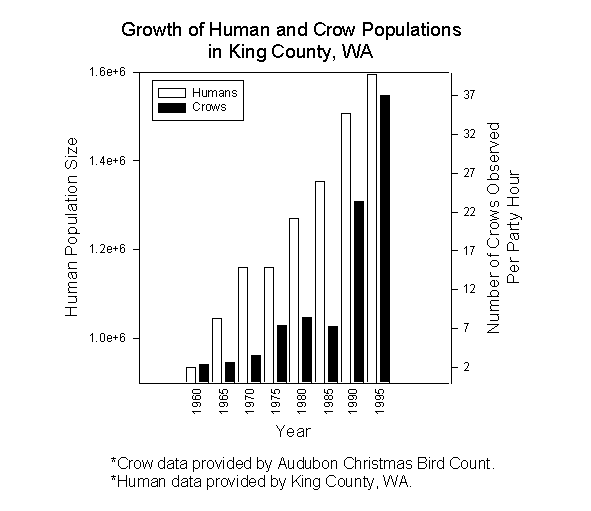
RESEARCH METHODS
Estimating Bird Productivity and Dispersal
We estimate the productivity of ten species (insert link to pictorial guide) of ground-nesting and shrub-nesting birds using a variety of techniques. We search for active bird nests during the breeding season. Once an active nest is found, we carefully monitor it until the young either die or fledge. This is the best technique for estimating productivity, but the nests of most birds are extremely difficult to find. Therefore, we supplement observations at real nests with a technique called spot-mapping (Vickery et al. 1992). Spot-mapping is a way to monitor the reproductive status of a breeding pair of birds over the course of the breeding season using behavioral cues. By the end of the season we have a good estimate of the number of young fledged on each territory (if any).
We capture birds in mist nets throughout the season and band their legs with
a uniquely numbered metal band and a unique combination of 3 plastic color bands.
Banding birds allows us to distinguish between birds on neighboring territories
and to detect movements if the bird is resighted or recaptured in a new location.
For more information on bird banding see the USGS Bird Banding Lab's homepage.
We also measure bird dispersal by radio-tracking juvenile birds after they have
fledged from the nest. A super-light-weight transmitter with an antenna is carefully
fitted to each bird with a flexible elastic leg harness. The batteries on the
radio transmitters provide a signal for 3-9 weeks, during which we record the
birds’ movements through urban areas.

Color-banded Song sparrow (photo by K. Whittaker)
Estimating Bird Abundance
We identify the bird species breeding on a field site and their
relative abundance using standard fixed-radius point count surveys. We randomly
identify locations that are approximately 200m apart. We visit each point five
times for a 10-minute period, during which we record each bird that we see or
hear. The data are summarized as the average number of birds counted per point
per 10-minute survey and used to calculate diversity statistics.
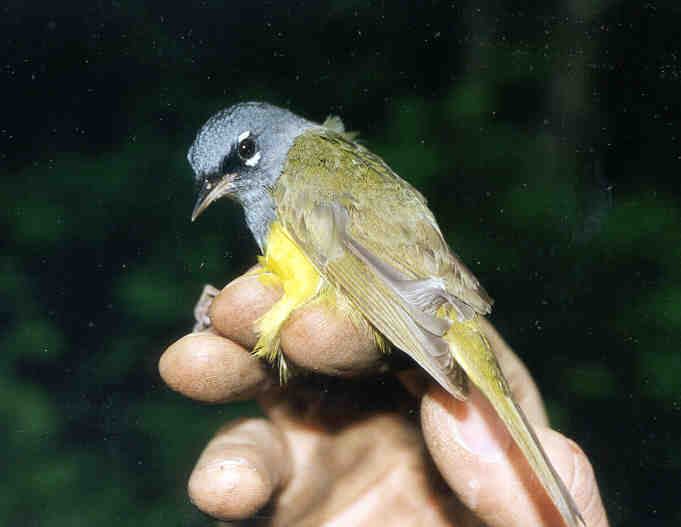
Male MacGillivray’s warbler (photo by R. Donnelly)
Monitoring American Crow survivorship and dispersal
American Crows are members of the family corvidae. As corvids are documented nest predators, we study the productivity, survivorship, and dispersal of American Crows at a subset of our study sites. Marking individuals is essential for estimation of survivorship and dispersal. Thus, each year we mark a many birds with a unique combination of colored legbands so that we can identify individuals with binoculars. Some crows are even fitted with a radio transmitter that emits a pulse over a unique radio frequency so that they can be tracked over long distances. The ability to detect dispersing juveniles over long distance became evident when one of the birds marked near the University of Washington moved about 30 miles NE to the town of Index. Birds carrying transmitters do so with a harness made of teflon webbing. The harness is designed to degrade after 1.5 years, the approximate life of the transmitter's battery. Please note that understanding the processes causing bird communities to change with urbanization necessitates the capture and marking of individual birds. These activities demands a great deal of training and are heavily regulated. For more information on these activities see the Migratory Bird Treaty Act and the USGS Bird Banding Lab's homepage.
OPPORTUNITIES FOR ASSISTANCE
Urban research on this scale would not be possible without the help of many people. Undergraduate students help us collect data in the field. Private landowners provide access to their land. Managers at a variety of public agencies provide logistic support for locating and working at field sites. If you are interested in assisting us, there are four ways that you can do so:
(1) if you are a UW undergrad, complete
an independent study project in conjunction with our research
(2) work as a research technician during the field season (roughly May 1 - August
1)
(3) report sightings of banded
crows
(4) report the location of large
crow roosts (large nightime aggregations of crows) in or near Seattle
(5) Volunteer on the monthly survey of crows in the Seattle Christmas Bird Count circle
(6) report sightings of colorbanded songbirds (need help identifying the species?)
INDEPENDENT STUDIES BY UW STUDENTS
Each year, a few undergraduates from the University of Washington participate in this research project by completing an independent study. These studies often fulfil academic requirements and include a stipend while field work is conducted. For more information, contact us.
Past independent studies have focused on:
(1) Correlations among morphology, behavior, and age in American Crows
(2) Importance of native shrubs to the breeding success of native shrub-nesting
songbirds
(3) Techniques for estimating the abundance of crows at roosts
(4) Variation in small mammal abundance with reserve size and landscape context
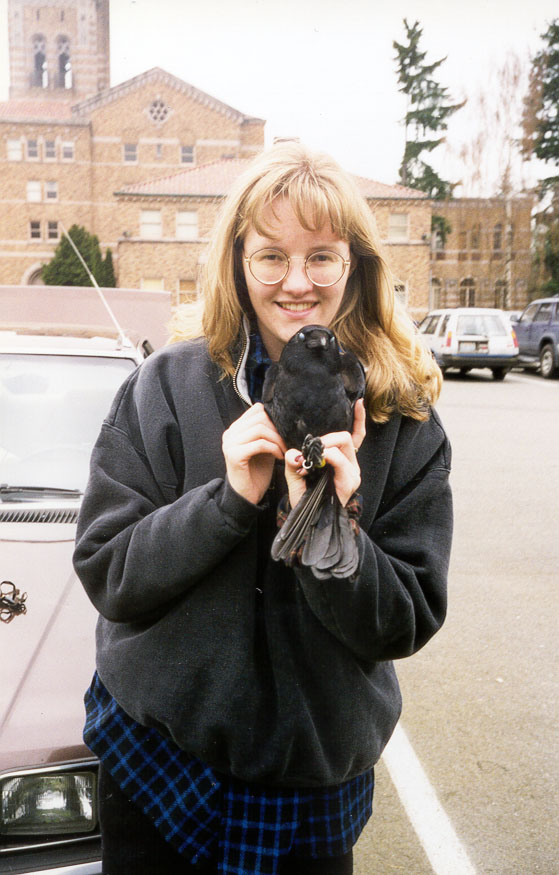
LANDSCAPING FOR NATIVE SONGBIRDS
The replacement of native vegetation with non-native plants is one of the primary causes of decline in animal populations. Therefore, to conserve wildlife, it seems that we must conserve native vegetation or "renovate" areas with too many exotic species. These actions appear to hold promise for the conservation of native forest birds in the Seattle area, as birds preferred to nest in native shrubs and groundcover over the past three years. If you are interested in enhancing the value of your property for native birds through landscaping with native plants, please read our fact sheet and visit the following links. Note that this type of landscaping can be very inexpensive if you coordinate with a "salvage" operation and may qualify you for a reduction in county property tax if you live in King County.
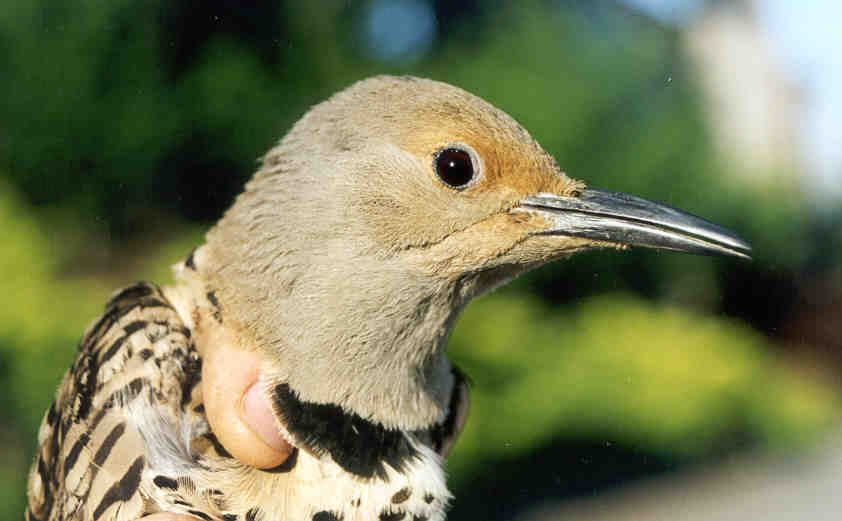
King County's Native plant "resources",
"nurseries",
"salvage"
Plant Conservation Alliance
Seattle Audubon Society's conservation
page
Washington Native Plant Society's "Gardening"
Washington State University's "Gardening
with native plants in Western Washington
REPORT BANDED AMERICAN CROWS
To report your sighting of a banded American Crow, read the following instructions then click this link to the report page. Once you have submitted the survey, your browser will automatically return you to the research homepage. When making crow observations it is extremely important that you correctly identify the exact color combination of the crow's bands. We typically band our crows with two bands on each leg. One leg will have two plastic color bands and the other leg will have a plastic color band above a metal (looks gray or silver) U.S. Fish and Wildlife band. In 2003 we started banding crows with 2 colors ABOVE the metal band, like the one pictured here. Make sure you note which bands are on the bird's right leg, which bands are on the bird's left leg, and which colors are on top (closest to the bird's body). Remember, if the crow has its back to you, its right leg is on your right. This bird has red over yellow over metal (USFWS band) on its left leg and orange over green on its right.

To facilitate data processing, please refrain from using commmas when entering text and use the colors provided below when reporting your sighting with a survey page. Some of the bands on the birds may have 2 white numbers or 2 white letters printed on them (e.g. 7 over 2). These markings are not as important for identification as the colors, but it is helpful if you can provide them. It is also helpful if you provide the activity of the bird at the time of your observation. I have provided six activities in the pulldown menu on the survey:
1 Foraging- actively eating or scanning for food
2 Perching- sitting on a limb or structure
3 Preening- manipulating feathers on its body or that of another bird
4 defending territory- chasing other birds out of the area and/or advertising territory by display and vocalization
5 Being Dead- self-explanatory
6 Other- please provide a brief description of the activity in question 13, if it is not provided as a choice in the pulldown menu
Thanks, in advance, for your participation in our research! To report your sighting of a banded American Crow, click this link to the report page.
PRESENTATIONS AND PUBLICATIONS
We periodically present results from our research in the form of oral presentations and publications. Here's a list of upcoming presentations and relevant publications.
Presentation:
| WHAT | WHEN/WHERE | WHO | WHAT ELSE |
| Seattle's Crows: A Seattle Audubon Society Class | 5/23/04, University of Washington, Seattle. | John Withey | Class information. |
| Evaluating function of urban forest patches: a three-dimensional approach | Wednesday, August 4, 2:10 p.m. Ecological Society of America 2004 annual meeting, Portland, OR | John Withey | Conference information. (requires registration) |
Publications:
Marzluff, J. M. 2005. Island biogeography for an urbanizing world: how extinction and colonization may determine biological diversity in human-dominated landscapes. Urban Ecosystems 8 (2):157-177.
Withey, J.C., and J. M. Marzluff. 2005. Dispersal by juvenile American Crows affects population dynamics across a gradient of urbanization. The Auk 122 (1): 205-221
Donnelly, R., and J. M. Marzluff. 2004. Importance of reserve size and landscape context to urban bird conservation. Conservation Biology 18 (3): 733-745
Withey, John C. and J.M. Marzluff. 2001. Seattle’s Urban Crows. Washington Park Arboretum Bulletin 63(3): 6-11.
Marzluff, J., R. Bowman, and R. Donnelly. 2001. Avian ecology and conservation in an urbanizing world. Kluwer Press, The Netherlands.
Marzluff, J., K. McGowan, C. Caffrey, R. Knight, and R. Donnelly. 2001. Causes and consequences of expanding American Crow populations in urban environments. In Marzluff, Bowman, and Donnelly, eds. Avian ecology and conservation in an urbanizing world. Kluwer Press, The Netherlands.
ACKNOWLEDGEMENTS
Many, many people have volunteered for this project. Without this help we would not be able to complete such a large scale research effort. We appreciate your assistance and have enjoyed your company. Thank you, thank you, thank you!
A short list of entities to which we owe a great deal:
Bainbridge Ometep Sister Island Association
(purveyors of fair traded, shade-grown
coffee)
College of Forest Resources
City of Sammamish
City of Seattle Parks
King County Parks
King County Public Benefit Rating System Program
King County Wildlife Program
National Science Foundation
Tony's Coffee
University of Washington
UW Urban Ecology
Program
Washington State Parks
RELATED LINKS
A Guide to the Laws and
Treaties of the United States for Protecting Migratory Birds
Baltimore Ecosystem Study
Central Arizona-Phoenix Long-term Ecological Research
Chicago Wilderness
Seattle Audubon Society's Homepage
Sierra Club's Legislative
Summary
WA Dept. of Fish and Wildlife's Summary
of the State's Growth Management Act
Washington State Legislature's Homepage
CONTACT INFORMATION
For more information, please contact:
Dr. John Marzluff
College of Forest Resources
University of Washington
Box 352100
Seattle, WA 98195
Graduate Students
John
Withey
Kara Whittaker
Dave Oleyar
Jack DeLap
Thomas Unfried
Stan Rullman